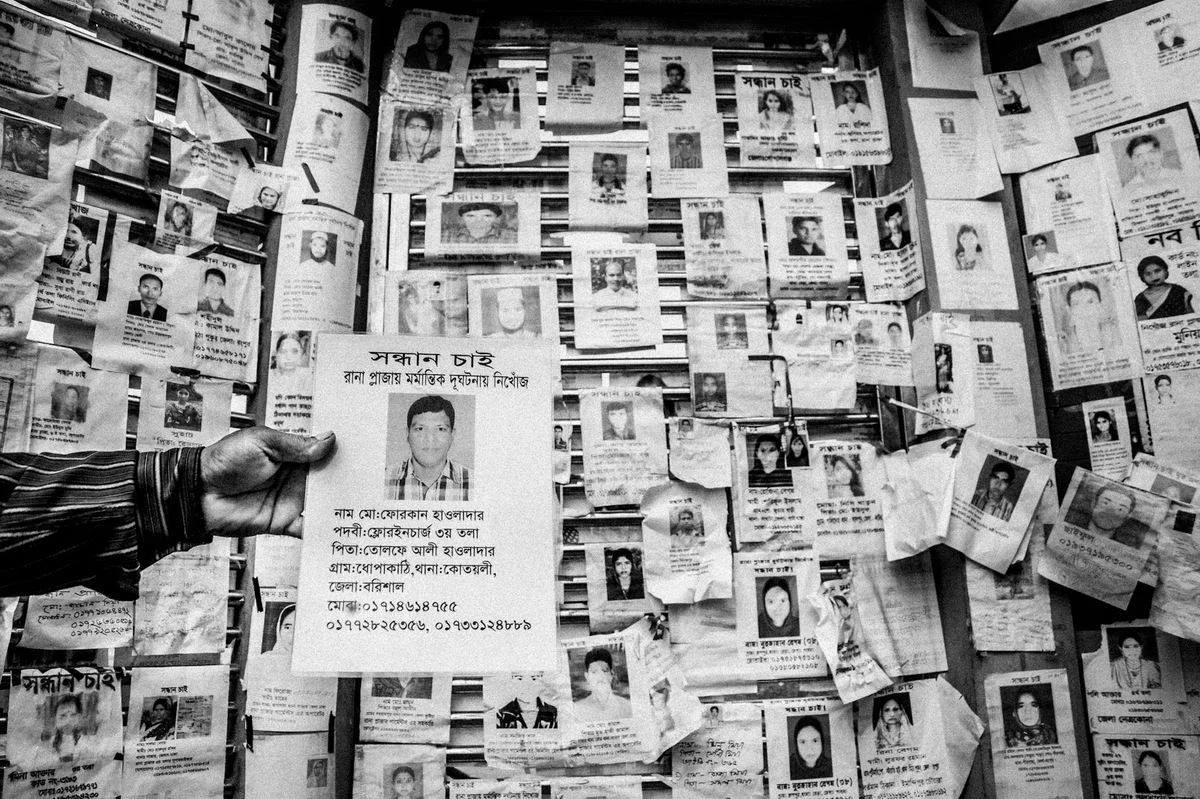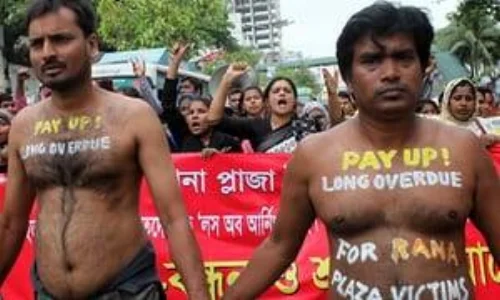Although five years have passed since the deadliest structural killing in history at Rana Plaza, providing adequate compensation for all the victims’ and affected families is still far away as the public interest litigation writ petition seeking court directives on the amount of compensation has not been heard by the court for last four years.
A day before the collapse, Rana Plaza cracked at several floors with a minor tremor and visibly tilted a little at noon, forcing all the workers of the five garment factories to leave the building in panic. Government engineer came in the afternoon to pacify the panic providing safety clearance for the building. The following day, on April 24, 2013, around 1,135 people were killed, more than 2500 got permanently disabled, and more than 100 workers went ‘permanently’ missing inside Rana Plaza.
A number of the world’s top fashion brands – Spain’s Mango, Inditex and (Zara), UK’s Matalan and Primark, Italy’s Benetton, Canada’s Joe Fresh – all have been found using suppliers based in Rana Plaza. To serve their interest, those poor youths were lured from their ancestral villages into the death trap of a building called Rana Plaza that obtained permission for six-story but later extended it by three more floors.
The global brands’ unending search for the cheapest labor in the world; their unstoppable greed to make more and their profit; and above all their gluttony paved the way for the deadliest structural killings in industrial history.
However, all the 42 people charged with culpable homicide’ in the case filed over Rana Plaza killings are local accomplices, meanwhile, after donating to Rana Plaza fund, Primark, H&M, Zara, and Mango are now launching between 40 to 50 ‘seasons’ a year, both meeting and generating consumer demand.
The dilemma of compensation
After Rana Plaza, IndustriALL Bangladesh Council demanded Tk 28 lakh compensation for each victim while Bangladesh Garment Manufacturers and Exporters Association (BGMEA) offered Tk 2 lakh. It is indeed a joke to expect the families of workplace accident victims to seek legal help and go to court, seeking compensation for the death or injury of their loved ones. If past history of industrial compensation in Bangladesh is any guide, each worker can expect to receive no more than Tk 2 lakh each. This amount might cover the cost of burial for the deceased, and some of the medical expenses of the survivors, but it can hardly compensate for the loss of life, pain, and suffering
What Rana Plaza survivors or victims’ families have gotten so far, from the government or the buyers, is a donation, not compensation. The amount of compensation is still under jurisdiction at a Dhaka court, still unsettled. How can an unsettled amount be paid?
We must keep in mind that donation is not compensation. Compensation is a right while a donation is just an act of charity. As different parties involved started citing different compensation amount, rights activist moved to the court.
Within a week after the collapse, Bangladesh Legal Aid and Services Trust and Ain O Salish Kendra (ASK), a human right organization, jointly filed a public interest litigation writ petition seeking the High Court’s directives on the amount of compensation. The court then ordered the government to form a committee ‘to determine adequate compensation for the victims’.
On January 23, 2014, the government-formed committee submitted its report to the court, proposing over Tk 14.5 lakh compensation to each of the deceased workers’ families and permanently disabled laborers. But no hearing has taken place since 2014 on the petition after the submission of recommendations, although the then chief justice ordered the holding of analogous hearings on the writ.
The donation provided by the government, the Bangladesh Garment Manufacturers and Exporters Association, or foreign buyers to only a section of victims is being portrayed intentionally as compensation by a vested group.
As per the committee recommendations, workers who lost one limb would get Tk 7.5 lakh while ones needing long time treatment Tk 4.5 lakh and mentally sick ones Tk 1.5 lakh. The committee had earlier proposed a minimum of Tk 20 lakh (around $26,000) for each of the dead or missing person, Tk 10 lakh each of those lost one limb, Tk 15 lakh for those lost two limbs and Tk 20 lakh each of the ones lost more than two limbs.
Bangladesh Garment Manufacturers and Exporters Association (BGMEA), who wants the compensation amount fixed according to Bangladesh Labour Law of 2006, termed the proposed amount ‘impractical’, arguing that ‘such an amount would discourage investors from continuing their business.’ BGMEA gave a note of decent to the committee, urging them to set the compensation amount at Tk 2 lakh.
Compensation and PM office
On the other hand, IndustriALL Bangladesh Council demanded compensation as per the International Labour Organisation (ILO) Convention of article 121, which is worth Tk 28 lakh.
In 2015, the Prime Minister’s Office (PMO), locking into a tug of war over with Transparency International, Bangladesh (TIB) all of a sudden denied the existence of any special Rana Plaza fund at PMO. According to a TIB, the fund worth Tk 105 crore is supposed to be left undistributed. while the PMO said, “There is no bank account in the name of Rana Plaza at the PM’s office. No cheque in the name of Rana Plaza came and released," the then PMO DG said.
Whereas three months after the Rana Plaza collapse, on July 14, 2013, Matia Chowdhury told the Parliament that different individuals and organizations had so far deposited Tk 127.67 crore to the Prime Minister's Relief Fund for Rana Plaza victims. The news was published in different newspapers on the following day.
Living after survival
A follow-up survey report released last week – conducted on 200 Rana Plaza survivors by Action Aid Bangladesh – shows that 48 percent survivors are at present out of employment due to their physical and mental weaknesses.
The survivors who are currently employed are engaged in different types of activities. 21.6% of the survivors have returned to garments factories, while a similar percentage is working as day laborers. This is a significant change from the last survey, where only 2 percent were working as day laborers.
In the survey, it was also found that 12% said that their condition is getting worse, 70.5% are more or less stable, and 17.5% are completely stable. In terms of psychological health, 22.5% are still in trauma in comparison to the 30.8% reported in the previous survey. Currently, 63 percent reported that they are more or less stable and 14.5 percent have recovered fully.
The cases linger on and on
Two cases were filed over Rana Plaza collapse, but there is no significant progress in the trial proceedings of those cases. The police filed a case of ‘culpable homicide’ and Rajdhani Unnayan Kartipakhya filed another case of building code violations. The murder case filed for the deaths of workers is pending with Dhaka District and Sessions Judges Court, being stuck at deposition stage.
Of the accused, Rana and six others are in jail while seven others are on the run and 27 are on bail. The court, after framing charges against 41 accused on July 18, 2016, has fixed many dates for recording statements of witnesses but time petitions have stalled it.
On April 21 last, the court set May 16 next for deposition in the culpable homicide case. In the second case filed for violating building code, a Dhaka Court on June 1, 2016, framed charges against 18 people.
According to the statement of the case filed by the Anti-Corruption Commission, the building authorities obtained permission for a six-story building but later extended it by three more floors.
The fashion brands
In the context of Rana Plaza victims’ right to compensation delayed, the global brands meanwhile are trying to wash their hands off by contributing to the Rana Plaza fund. They are still reluctant to come to terms with the fact that their greed for money is primarily responsible for what happened.
The issue of compensation of more than 3,000 families is being deliberately ignored, like the imminent probability of the collapse was, to satisfy these profit-hungry fashion brands. The government representative, the engineer, who provided the safety clearance, only fulfilled the will, an accomplice with the building owner, of the buyers from Europe, US, and Canada.
In order to ensure the buyers’ profit, their local accomplices forced the workers to enter a building that cracked and tilted a day before, under the threat of losing the job. One becomes dumbfounded losing the power to think how it could happen if he sees a particular you tube video of a local TV channel report. In the video, a teenage garment laborer is seen forecasting his death on April 23, only a day before the collapse.
Only a day before the April 24 collapse, the teenager prophetically answers to the cameraperson laughing, “What do you mean by if we afraid? we all came out in panic, the shift was called off…now they are miking that we must join work tomorrow threatening the workers of losing job…look, the building has already tilted, cracked; at any moment it will break down with a big thud…dhopppass!”
Notice that, when the teenager was apprehending his imminent death, in front of a camera, if forced to work in Rana Plaza; the government, at the same time on the same day, is giving the safety clearance after inspection for that very building, the workplace of more than seven thousand mostly female workers, the world’s cheapest.
The boy, needless to say, died the next day inside the building with more than 1200 co-workers. Why did he go if he knew before? Very easy. Who wants to lose his job these days?
Still far away?
So, it seems the establishment of a right to compensation for workplace death and for being permanently disabled of Rana Plaza victims is still far away. The amount of compensation is still under the jurisdiction, is yet to be fixed by the court. But no hearing has taken place since 2014 on the petition after a committee.
Meanwhile, long five years have passed. The families of deceased victims and permanently disabled are still waiting for the much-talked compensation, with disbelief in their hearts.
Writer: Tariq Al Banna, Author & Journalist. Photos: Abir Abdullah, Rahul Talukder, Taslima Akhter & some collected from news media.







